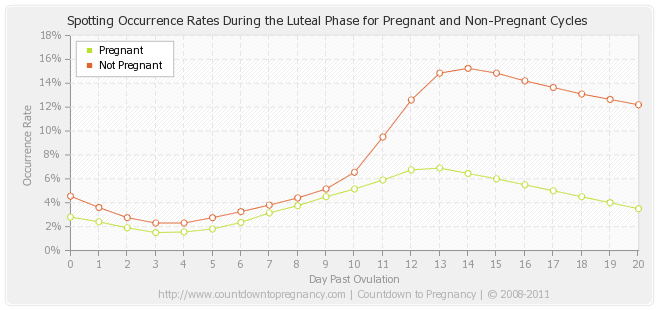Spotting during the luteal phase
and the effect on the probability of pregnancy
A study examining the occurence rate of spotting during the luteal phase and it's effect on the probability of pregnancy.

Note: The information in the graph above is compiled from the symptom data that has been contributed by our users on this site. It relates only to the luteal phase, the period of 14-20 days past ovulation (DPO), between ovulation and when menstruation would be expected to begin if pregnancy has not occurred. The information must be distinguished from results and statistics in pregnancy literature about "early pregnancy", which generally refers to a much longer period.
Summary
The chance that spotting will happen on any given DPO is greater for non-pregnant women than for pregnant. In DPOs 0-9 this means that spotting is a slightly negative indicator for pregnancy.
In DPOs 10-20, in contrast, it is a strongly negative indicator since the primary cause of spotting in those DPOs is oncoming menstruation. The large bulge in the non-pregnant curve shows this clearly.
The higher occurrences of spotting at DPOs 0 and 1 are very likely due to ovulation spotting.
The curious fact that chances of spotting are higher for non-pregnant cycles in DPOs 0-5, even though this is before implantation occurs, is something for which we have no explanation at this time.
The occurrence of spotting increases steadily, and in parallel, from DPO 5, in pregnant and non-pregnant cycles, reaching its peak at the time when menstruation occurs, or would have been expected to occur. This phenomenon is confirmed in the literature.
There is no solid evidence in the graph for the occurrence of so-called implantation spotting.
Detailed discussion and statistics
The over-all probability of pregnancy (POP) among the cycles of women who are trying to conceive is around 20%. In a cycle with no spotting at all, the POP is about 25%. That is to say, spotting, generally, is a negative indicator for pregnancy.
Note: About 70% of non-pregnant cycles and 85% of pregnant cycles show no spotting at all.
Spotting that occurs in DPOs 0-9 reduces the POP to 15-18%. Spotting in DPOs 10-20 reduces POP to 6-8%, for the obvious reason that most spotting in this interval is a precursor to menstrual bleeding among the non-pregnant.
| Probability of pregnancy based on spotting | |
|---|---|
| Average probability of pregnancy each cycle | 20% |
| Probability of pregnancy in a cycle with no spotting during the luteal phase | 25% |
| Probability of pregnancy in a cycle with spotting on 0-9 DPO | 15-18% |
| Probability of pregnancy in a cycle with spotting on 10-20 DPO | 6-8% |
Implantation spotting
The process of implantation usually occurs between DPOs 6 and 11. If implantation spotting happens, it should be in that interval. Implantation spotting implies pregnancy, and so if implantation spotting is a significant component of the total spotting in DPOs 6-11, we would expect a bulge in the pregnancy curve and a noticeable increase in POP among those experiencing spotting in the implantation window.
Such expectations are not met in this graph. The pregnancy curve rises smoothly in parallel with the non-pregnant curve and there is no increase in POP. We have to conclude that implantation spotting, if it occurs at all, is so infrequent that it has no impact on the shape of the pregnancy curve. Any spotting that occurs during the implantation phase is more likely caused not by the act of implantation, but by other hormonal factors. In general, the causes of any spotting during the luteal phase are not well understood.
Note: Only 15% of pregnant cycles have spotting of any kind in DPOs 6-11. That means that no more than 15% of pregnant cycles experience implantation spotting, and the actual percentage is very likely far less.
Spotting between 0 and 5 DPO
Notice in the graph that the occurrence of spotting in DPOs 0-5 is greater for non-pregnant cycles than for pregnant. This result has solid statistical significance supporting it. And yet common sense would suggest that since implantation has not occurred, the woman's body does not yet "know" it is pregnant, and so spotting should be equally likely, pregnant or not. Our data says otherwise, but we have no explanation.
Calculator
Use the Luteal phase spotting calculator to calculate your probability of pregnancy (%) based on any recent luteal phase spotting.


